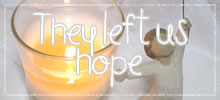When I got off my mission I had roughly one year left at BYU before I finished my bachelor’s degree. I took a few classes during the summer and then did my student teaching in the fall (I should really blog about that experience some time too). I only had three classes I had to take during the winter semester of 2002 and I’d be done. So I took seven classes. And I’m so very grateful I did. Two of those extra four classes turned out to be two of the four most influential classes I have taken in my entire life. Today I want to blog about one of them.
My mission mom, Sister Paulsen, was teaching a class on Mormon folklore that semester, and I decided that would be a fun class to take. I had no idea of the work that would be involved in it. But I loved it. It changed how I looked at the world around me and my place in it. And that has spilled over to affect how my parents and a few others also look at the world. Truly a life changing class.
The final was a two parter. One part was written, but for the other part we went to Salt Lake and toured the Chase Home Museum of Folk Arts (Chase is an ancestor of mine as well) at Liberty Park. Then we went to the Church History Museum. We then went to the Paulsen home and shared traditional foods from our family before walking up the street to her neighbor’s home to talk with him and see what he had in his house. Richard Oman is a curator of the Church History Museum. He has also traveled a lot with his family and has many things from his travels in his home.
I know that the class would’ve had a large impact on my life if I had just stopped there, but I didn’t. I continued to be a small part of the folklore world in Utah. And for the next 5+ years, until I moved away from Utah, I also continued to participate in the home part of the final every semester, visiting with Richard Oman and learning a bit more every time.
First, the definition of art needs to be redefined. Just as if you were to define fruit as being apples and then went to Hawaii, you’d say there just wasn’t a whole lot of fruit there because you didn’t see any apples and you’d be missing out on the guava and mango and pineapple and so many others; if you define art as being granite sculpture or oil paintings, you miss out on the art that is all around us. Art is anything that is created to make your world look better, more pleasing to the eye.
As he would talk about the things in his house, things others had made, things he had made, the reasons they had been made, the symbolism and meaning behind all of them, he would lead up to the parting thoughts that I would then mull over till the next time.
When we think of God, when we think of his characteristics, we can say that He is loving, kind, all knowing, serving. But he is also the Creator of heaven and earth and all things that in them are. And we have been commanded to be like Him. We cannot get to the end of our lives and stand before him and say, “You know, loving, it just wasn’t my thing. I wasn’t born with those talents.” But many people have no problem saying, “You know, creating, it just isn’t my thing. I wasn’t born with those talents.” Do you see the contradiction there?
And how did God create? He created this world based on other worlds he had created. He’d had practice. He wasn’t starting completely from scratch but was building on previous work. He had a pattern he was copying. And when you look at the great works of art through history, they had practice and they built not only on their previous work, but on the previous works of the masters before them. It is only recently that “art” is supposed to be something created completely from scratch without any regard to what has come before (and I actually think most of it is more on the ugly side too, I prefer something with history and meaning and a heritage to fall back on).
So why do we think we are supposed to create completely from scratch without any regard to what has been created before us if that is not how God creates? Go ahead, copy from people who have made other things. Use their ideas. Practice. Add your own esence to what someone else did. And enjoy the process. I firmly believe that part of why God rested on the seventh day of creation was because he wanted time to just sit back and enjoy the beauty that is this earth. Above all though, make something that is meaningful to you.
What have I done with this? I quilt. I make quilts to commemorate events in the lives of my family. I make quilts that are special to me. I’m working on a wall hanging quilt that will be a visual representation of my testimony. It is not a quilt I would ever submit to a quilt show to be judged of others, but it is a quilt I will cherish because of the value it has for me. When you come to my home you can’t help but see that I quilt. And I could show you mistake after mistake in pretty much all of them. But I am creating. I am making my world a more beautiful place. I am sharing my growing talents with those who are special to me by sewing a piece of me into those quilts and giving them to them. I learned to quilt from others. My mom taught me to sew. The patterns I use are generally variations of patterns others have done, some times with larger variations than others. I did not start completely from scratch with my quilting and creating.
Can I create a world? No. But I can create small things. I am building my creative characteristics.
And these are things I have been learning, doing, and sharing with others for many years now. And that is why when I listened to President Uchtdorf’s address at the General Relief Society Meeting in October, “Happiness, Your Heritage,” I wrote in my notes: creation – what I learned at folklore finals. I am glad that more people got the message though. Now, what will you do with it? What will you create?

 I am an educator and PhD. I quilt, belly dance, run, read, and try to grow things. I am a Mormon. I am infertile. I am a daughter, sister, aunt, grand-daughter, friend, wife, and mom.
I am an educator and PhD. I quilt, belly dance, run, read, and try to grow things. I am a Mormon. I am infertile. I am a daughter, sister, aunt, grand-daughter, friend, wife, and mom.














I read the entire Conference edition before the next Conference (so May before October, November before April). Today I was finishing reading the talks from the General Relief Society Meeting, in particular President Uchtdorf’s message.
People are missing the whole point of his talk! It was not (solely) about creating. Creating isn’t even in the title! It’s about finding happiness, the highest degree of happiness that exists, God’s happiness. And then he talks about ways that we can find and experience the same happiness that God has. And we do that by emulating God in his aspects of creation and being compassionate.
It’s a talk about happiness, about how as daughters of God, the creator of all and compassionate to all, our purpose is to seek and experience the same eternal happiness that God experiences.
So just be happy already, k?
Pingback, 31 March 2009 at 11:49 am
Expressions in art | Random Giggles
Pingback, 31 July 2011 at 8:15 pm
Intelligence | Random Giggles